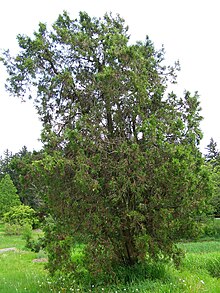Platycladus
| Chinese arborvitae | |
|---|---|
 |
|
|
Platycladus orientalis Morton Arboretum acc. 168-53#3 |
|
| Scientific classification | |
| Kingdom: | Plantae |
| Division: | Pinophyta |
| Class: | Pinopsida |
| Order: | Pinales |
| Family: | Cupressaceae |
| Genus: |
Platycladus Spach |
| Species: | P. orientalis |
| Binomial name | |
|
Platycladus orientalis (L.) Franco |
|
| Synonyms | |
|
|
Platycladus is a distinct genus of evergreen coniferous tree in the cypress family Cupressaceae, containing only one species, Platycladus orientalis, also known as Chinese thuja,Oriental arborvitae,Chinese arborvitae, biota or oriental thuja. It is native to northwestern China, Korea, and the Russian Far East (Amur + Khabarovsk). It is also now naturalised as an introduced species elsewhere in Asia: eastward to Japan; southward to northern India; and westward to northern Iran.
Although generally accepted as the only member of its genus, it has been suggested that the closely related species Microbiota decussata could be included in Platycladus, but this is not widely followed. Other fairly close relatives are Juniperus and Cupressus, both of these genera being graft-compatible with Platycladus. In older texts, Platycladus was often included in Thuja, which is reflected in one of its common names, "oriental thuja". But it is only distantly related to the genus Thuja. Differences include its distinct cones, wingless seeds, and its almost scentless foliage.
The binomial Platycladus means "with broad or flattened shoots". The qualifier orientalis refers to its native habitat in China.
The common name 'arborvitae' is from Latin, 'tree of life', and is based on its association with long life and vitality in Buddhist thought in China. This is probably based on the tree's unchanging evergreen nature in the cold dry climate of northwest China, and its longevity; some of the larger specimens planted around Buddhist temples in China are said to be in excess of 1,000 years old. It is called ce bai (側柏) in Chinese.
...
Wikipedia

